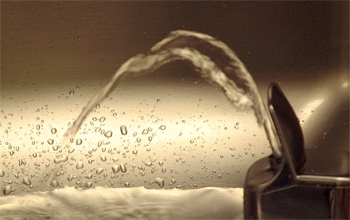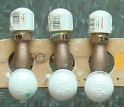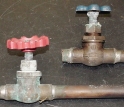News Release 05-131
Your Tap Water: Will That Be Leaded or Unleaded?
Lead may pose greater leaching risk than standard tests show

A recent study suggests that testing protocols may not accurately measure lead leaching.
August 4, 2005
This material is available primarily for archival purposes. Telephone numbers or other contact information may be out of date; please see current contact information at media contacts.
In critiquing a common safety standard, researchers have found the testing regimen may not detect lead that could be leaching from brass plumbing parts.
As a result, the researchers believe some of the lead creeping into tap water in Washington, D.C., and other metropolitan areas may trace to fixtures, valves and other components--not just pipes further from the home.
The new study looked at the American National Standards Institute/National Sanitation Foundation 61 Section 8 standard--a protocol consisting of specific methods and test-water formulas that governments and industries have relied upon to ensure safe plumbing since 1988.
"As a result of problems identified with the test protocol, some products passing National Sanitation Foundation Section 8 may have a greater capacity to leach lead into water than we believed," said Marc Edwards of Virginia Tech, who is one of the study leaders.
Edwards, Abhijeet Dudi and Nestor Murray, all at Virginia Tech, and Michael Schock, of the Environmental Protection Agency (EPA) National Risk Management Research Laboratory, report their findings in the Aug. 4 issue of the Journal of the American Waterworks Association.
Edwards, Dudi and Murray are members of a multidisciplinary team supported by a National Science Foundation Materials Use: Science, Engineering and Society (MUSES) award.
The researchers tested identical brass devices purchased from a local hardware store by subjecting the pieces to the Section 8 protocol and to modifications they made to the protocol. They also applied the same tests to a simulated plumbing device made of solid lead.
The results: The Section 8 water samples reacted less, or were less "aggressive," with lead in the plumbing than designers of the standard had intended. The researchers found other problems that stemmed from calculations that underlie some of the test results. Normalization factors allow evaluators to estimate actual lead concentrations at the tap, but they are affected by device size. Because of normalization and the non-aggressive waters, the small, simulated device made of pure lead pipe passed the Section 8 leaching test.
The scientists began to scrutinize the Section 8 methods after learning that one of the test solutions contains high concentrations of orthophosphate to buffer the water's pH. Water utilities use orthophosphate actually to inhibit lead leaching. So, test solutions containing such leaching inhibitors could not react adequately with plumbing and would produce a flawed reading.
"It's analogous to an automobile crash test using a wall of pillows," Edwards said.
Because lead softens alloys, it is an important component in many plumbing metals. Without adding small quantities of lead, manufacturers could not craft intricate shapes necessary for modern devices. Under certain chemical conditions, such as high acidity or low amounts of carbon dissolved from minerals, the devices can leach significant amounts of that lead into water.
The problem is complex because treatments necessary to treat one water-quality problem, such as bacteria, can have unintended consequences, such as lead leaching.
In the 1986 Safe Drinking Water Act as amended in 1996 (USEPA, 2000), Congress explicitly banned new devices containing pure lead pipe, leaded solders, and brass with more than 8 percent lead content. However, these materials remain installed in older homes.
At the time of the legislation, there were no alternatives for leaded brass, and experts believed it was not feasible to reduce lead content in devices to that in pipes and solder.
Some components are labeled lead-free, even if they contain 7.99 percent lead. Despite such labeling, all brass products that contain lead must pass the Section 8 performance-testing standard.
Recently, legislators have proposed updated laws to allow for modern brass alloys--some containing as little as 0.02 percent lead or less by weight--which could reduce lead leaching considerably .
-NSF-
-
These hose bibs were used in the Virginia Tech study.
Credit and Larger Version -
These ball valves are examples of devices covered by the Section 8 standard.
Credit and Larger Version
BE-MUSES: Towards Sustainable Materials Use for Drinking Water Infrastructure
http://www.nsf.gov/awardsearch/showAward.do?AwardNumber=0329474
Media Contacts
Joshua A. Chamot, NSF, (703) 292-7730, email: jchamot@nsf.gov
Lynn Nystrom, Virginia Polytechnic Institute and State University, (540) 231-4371, email: tansy@vt.edu
Program Contacts
Delcie R. Durham, NSF, (703) 292-7060, email: ddurham@nsf.gov
Principal Investigators
Andrea Dietrich, Virginia Polytechnic Institute and State University, (540) 231-5773, email: andread@vt.edu
Co-Investigators
Marc Edwards, Virginia Polytechnic Institute and State University, (540) 231-7236, email: edwardsm@vt.edu
Related Websites
Marc Edwards homepage: http://www.cee.vt.edu/people/edwards.html
Andrea Dietrich homepage: http://www.cee.vt.edu/people/dietrich.html
The U.S. National Science Foundation propels the nation forward by advancing fundamental research in all fields of science and engineering. NSF supports research and people by providing facilities, instruments and funding to support their ingenuity and sustain the U.S. as a global leader in research and innovation. With a fiscal year 2023 budget of $9.5 billion, NSF funds reach all 50 states through grants to nearly 2,000 colleges, universities and institutions. Each year, NSF receives more than 40,000 competitive proposals and makes about 11,000 new awards. Those awards include support for cooperative research with industry, Arctic and Antarctic research and operations, and U.S. participation in international scientific efforts.
Connect with us online
NSF website: nsf.gov
NSF News: nsf.gov/news
For News Media: nsf.gov/news/newsroom
Statistics: nsf.gov/statistics/
Awards database: nsf.gov/awardsearch/
Follow us on social
Twitter: twitter.com/NSF
Facebook: facebook.com/US.NSF
Instagram: instagram.com/nsfgov


